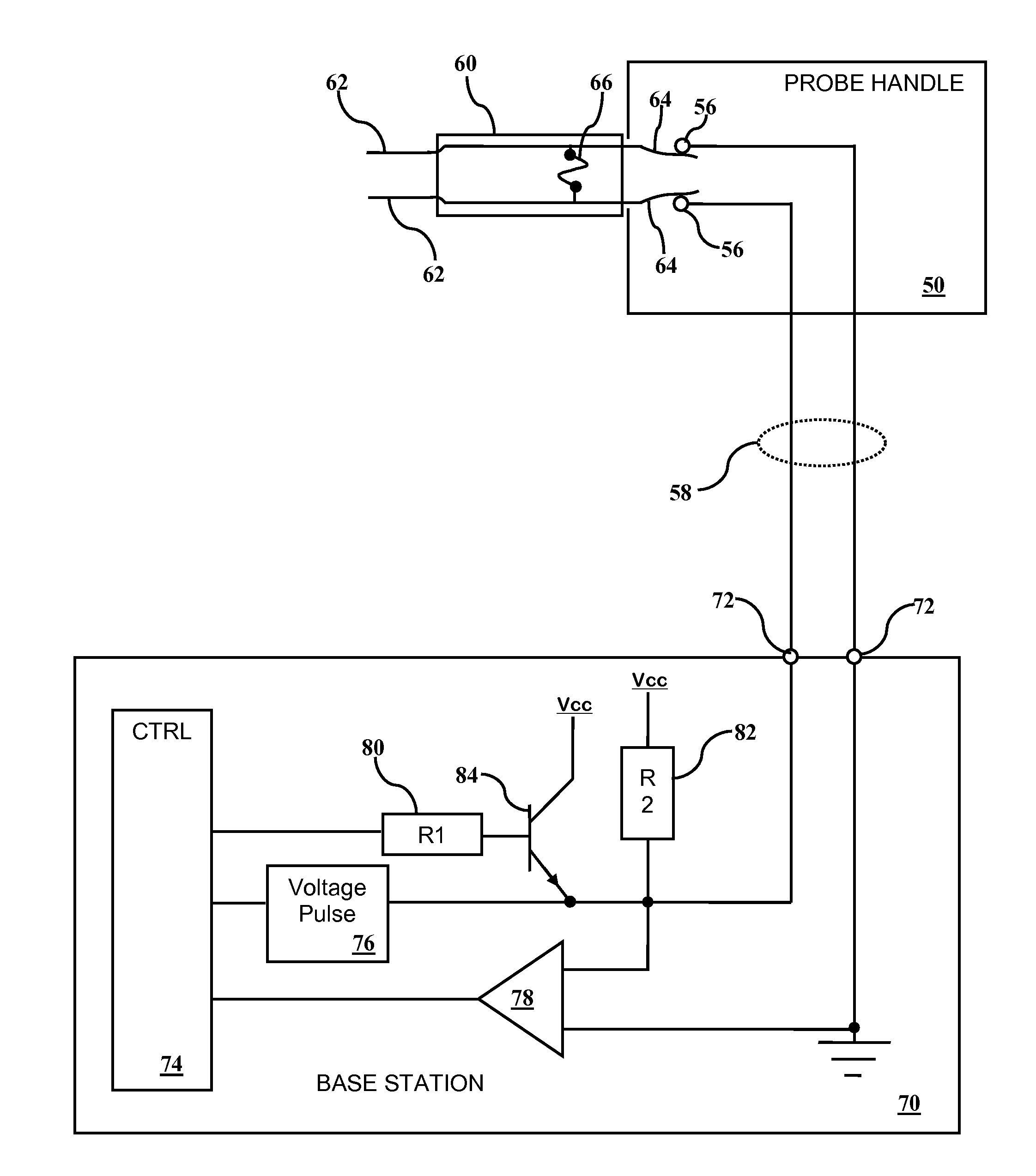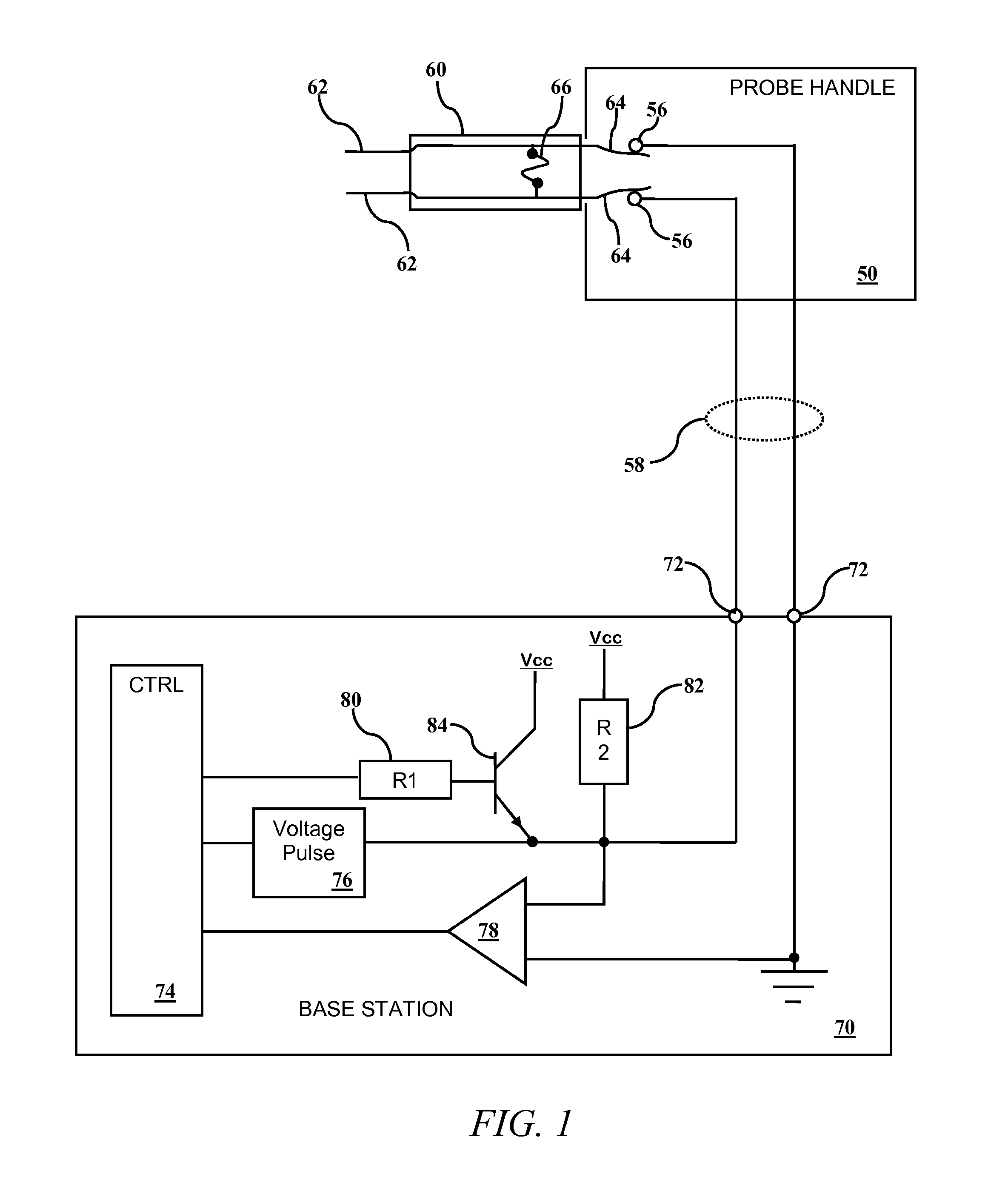System, method and apparatus for preventing reuse of medical instruments
a medical instrument and reuse technology, applied in the field of medical devices, can solve the problems of not being able to completely sterilize, difficult to find materials that cover all forms of sterilization, and difficult to sterilize during manufacture, so as to prevent reuse, prevent reuse of disposable medical devices, and prevent reuse
- Summary
- Abstract
- Description
- Claims
- Application Information
AI Technical Summary
Problems solved by technology
Method used
Image
Examples
first embodiment
[0026]Referring to FIG. 1, a schematic view of a system of the present invention will be described. In this embodiment, a fuse 66 is embedded in the probe 60. In this embodiment, the fuse is shown bridging the two probe conductors 64, while in other embodiments having more than two conductors between the probe 60 and probe handle 50, other fuse arrangements are envisioned. The fuse 66 is an indicator that identifies whether the probe 60 has been previously used. If the fuse 66 is conductive, it is believed that the probe 60 has not been previously used. If the fuse 66 is blown (non-conductive), it is believed that the probe 60 has been previously used. In this embodiment, the probe 60 has two probe tip conductors 62 that are electrically coupled to connector pins 64 in the base of the probe 60. The connector pins 64 mate with connector pins 56 within the probe handle 50, which are in electrical communication with a base station 70 through a cable 58 or other means. In some embodimen...
second embodiment
[0028]Referring to FIG. 2 along with FIG. 2A, FIG. 2B and FIG. 2C, a system of the present invention will be described. In this embodiment, an ID device 67 is embedded in the probe 60. In this embodiment, the ID device 67 is shown bridging the two probe conductors 64, while in other embodiments having more than two conductors between the probe 60 and probe handle 50, other ID device 67 arrangements are envisioned. The ID device 67 is an indicator of whether the probe 60 has been previously used. The ID device 67 has a unique or statistically unique characteristic that is detectable by the base station 70 through the probe handle 50. Many ID devices 67 are envisioned including tuned circuits such as capacitors, inductors and parallel or serial capacitors and inductors. In some embodiments, the ID device 67 is a ROM / EPROM / EEPROM / FLASH, preferably a serial version to reduce pin / conductor requirements. In all examples of ID devices 67, each device has a statistically unique characterist...
third embodiment
[0032]Referring to FIG. 3, a schematic view of a system of the present invention will be described. RFIDs 68 are known in the industry as are RFID readers. RFIDs (radio frequency identification devices) 68 contain a data stream that is usually unique, providing a serial number. The serial number is read by radio frequency (RF) radiation from the RFID reader 52 through a wireless connection. The RFID 68 uses parasitic RF energy to power itself and transmit its identification code or serial number. In some embodiments, the RFID reader 52 is integrated into the probe handle 50 (as shown in FIG. 3) while in other embodiments, it is integrated into the base station 70 or external to the base station 70. It is preferred that the RFID reader 52 be located in the probe handle 50 for several reasons. First, its close proximity to the probe 60 allows more accurate readings of the RFID 68 within the probe utilizing less transmission power. Second, because lower transmission power is used, the ...
PUM
 Login to View More
Login to View More Abstract
Description
Claims
Application Information
 Login to View More
Login to View More - R&D
- Intellectual Property
- Life Sciences
- Materials
- Tech Scout
- Unparalleled Data Quality
- Higher Quality Content
- 60% Fewer Hallucinations
Browse by: Latest US Patents, China's latest patents, Technical Efficacy Thesaurus, Application Domain, Technology Topic, Popular Technical Reports.
© 2025 PatSnap. All rights reserved.Legal|Privacy policy|Modern Slavery Act Transparency Statement|Sitemap|About US| Contact US: help@patsnap.com



